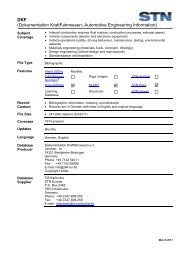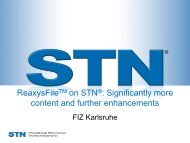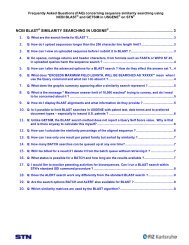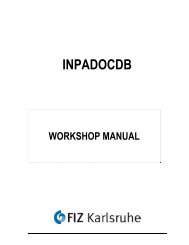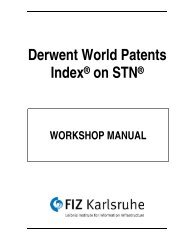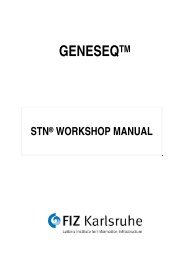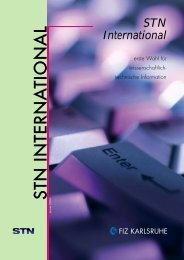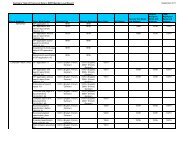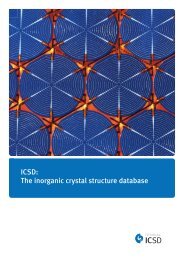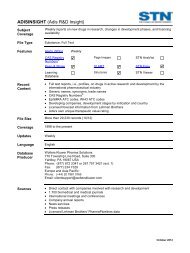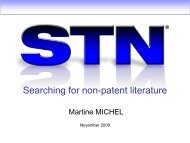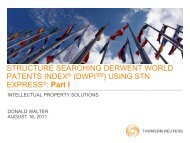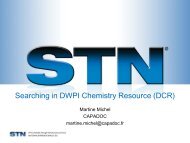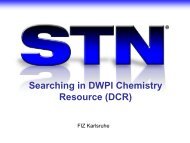STN Sequence Databases - FIZ Karlsruhe
STN Sequence Databases - FIZ Karlsruhe
STN Sequence Databases - FIZ Karlsruhe
Create successful ePaper yourself
Turn your PDF publications into a flip-book with our unique Google optimized e-Paper software.
<strong>Sequence</strong> Searching on <strong>STN</strong> ®<br />
Part I: <strong>STN</strong> <strong>Sequence</strong> <strong>Databases</strong>
Agenda<br />
• <strong>STN</strong> sequence searchable databases<br />
• Comparison to web-based resources<br />
• Results of a comparative search example<br />
• Summary and resources<br />
2<br />
2
<strong>STN</strong> sequence searchable databases<br />
• DGENE<br />
– Thomson Reuters GENESEQ TM<br />
– Value-added patent sequence data from around<br />
the globe<br />
• USGENE ®<br />
– The USPTO Genetic <strong>Sequence</strong> Database<br />
– A new and unique access point to USPTO<br />
sequence data<br />
3<br />
3
<strong>STN</strong> sequence searchable databases (cont.)<br />
• PCTGEN<br />
– WIPO/PCT Patent Application Biosequences<br />
– The complete collection of e-published<br />
sequences from WIPO<br />
• CAS REGISTRY SM<br />
– Chemical Abstracts Service (CAS) REGISTRY<br />
– Worldwide value-added patent and non-patent<br />
sequence data<br />
4<br />
4
Thomson Reuters GENESEQ (DGENE)<br />
• Largest value-added patent sequence database<br />
• Used routinely by all major patent offices*<br />
• <strong>Sequence</strong>s from the basic patents of the 43<br />
authorities of the Derwent World Patents Index ®<br />
• Bibliography, enhanced title, abstract, indexing,<br />
and patent location provided for each sequence<br />
• Patent Family and Legal Status display<br />
• Updated every two weeks<br />
• 1981 – present<br />
* See page 11: www.trilateral.net/projects/biotechnology/guide2.pdf<br />
5<br />
5
Relationship between DWPI patent family<br />
and DGENE sequence database<br />
AN .... WPINDEX<br />
TI ….<br />
PA ….<br />
PI WO …. A1<br />
AB ….<br />
FR …. A1<br />
US …. A1<br />
US …. B2<br />
WPINDEX = Derwent World Patents Index (DWPI SM ) on <strong>STN</strong><br />
DGENE = GENESEQ on <strong>STN</strong><br />
AN .... Protein DGENE<br />
PI WO …. A1<br />
SEQ 1 ….<br />
AB …… AN .... DNA DGENE<br />
PI WO …. A1<br />
SEQ 2 ….<br />
AB …… AN .... Peptide DGENE<br />
PI WO …. A1<br />
SEQ n ….<br />
AB ……<br />
6<br />
6
What exactly is the “value-add” in DGENE?<br />
• DWPI patent title, concise sequence description,<br />
abstract, and keyword indexing per sequence<br />
– Context of each sequence illuminated within the<br />
invention<br />
– Superior text-based refinement of sequence searches<br />
– Efficient scanning and review of search results for<br />
relevance<br />
• Feature tables for sequence<br />
modifications/annotations<br />
– Extensive detailed annotations provided by indexers<br />
7<br />
7
What exactly is the “value-add” in DGENE?<br />
(cont.)<br />
• Patent sequence location (claim, example,<br />
etc.)<br />
– Assigned manually by Thomson Reuters<br />
indexers<br />
– Flexible filtering of searches to those described<br />
in the claims<br />
• <strong>Sequence</strong>s intellectually derived by indexers<br />
– Unique sequence hits not disclosed in formal<br />
listings<br />
8<br />
8
Some editorial insights regarding<br />
WIPO/PCT sequences indexed in DGENE<br />
• On average 120 WIPO/PCT basic patents have<br />
sequences indexed into DGENE each week<br />
• Of these, about 15-20 may have electronic listings<br />
available – the rest are keyed manually<br />
– <strong>Sequence</strong>s are independently double-keyed with a<br />
guaranteed accuracy of 99.995% (1 in 20,000)<br />
• About 15% of PCTs with electronic listings have<br />
extra sequences indexed from the specification<br />
• Typically 1 or 2 documents per week will also have<br />
intellectually derived sequences indexed, based<br />
upon the wording of the patent claims<br />
Source: Colin Williams, GENESEQ Editorial & Content Manager, Thomson Reuters (12/2006)<br />
9<br />
9
Derived sequences are intellectually<br />
created by indexers from wording in the<br />
patent text<br />
AN AEJ92622 protein DGENE<br />
TI Hydrolyzing/synthesizing carboxylic acid ester/amide from<br />
chiral/prochiral reactants for preparing e.g. pharmaceuticals,<br />
comprises contacting reactants with a polypeptide having hydrolytic<br />
activity.<br />
IN Svendsen A; Vind J; Brask J; De Maria L<br />
PA (NOVO) NOVOZYMES AS.<br />
PI WO 2006084470 A2 20060817 17<br />
In this example, the indexer has<br />
intellectually derived this sequence<br />
from the wild type lipolytic hydrolase.<br />
AI WO 2006-DK76 20060210<br />
PRAI EP 2005-388012 20050210<br />
PSL Claim 16<br />
DED 19 OCT 2006 (first entry)<br />
LA English<br />
OS 2006-560037 [57]<br />
DESC Variant fungal lipolytic hydrolase #2.<br />
KW hydrolysis; lipase; pharmaceutical; pesticide; enzyme; mutein.<br />
ORGN Thermomyces lanuginosus. Synthetic.<br />
AB The new invention relates to a enzymatic method of hydrolyzing or<br />
synthesizing carboxylic acid ester or amide from chiral or prochiral<br />
reactants, by providing reactants for hydrolysis or synthesis, and<br />
contacting the reactants with a polypeptide which has hydrolytic<br />
activity on ester or amide, and a sequence 50% homologous to<br />
Thermomyces lanuginosus lipase. Also described is a polypeptide,<br />
which has hydrolase activity on an ester or amide substrate, and has<br />
an amino acid sequence that has at least 80% identity to SEQ ID No:<br />
5 and compared to SEQ ID No: 5 comprises a substitution corresponding<br />
to I90Q, N92TD, F95Y, F113Y, I202M, V203GM, L269T and 270F. . . . .<br />
10<br />
10
Indexers explain exactly how they derived<br />
the sequence at the end of the abstract<br />
The polypeptide is at least 80% homologous to any of SEQ ID No: 1-6<br />
being amino acid sequences of lipolytic enzymes of fungus such as<br />
Rhizomucor miehei (SWISSPROT P19515), Rhizopus delemar, Fusarium<br />
oxysporum, Penicillium camemberti (SWISSPROT P25234), Thermomyces<br />
lanuginosus (SWISSPROT 059952) and Thermomyces ibadanensis . . . . .<br />
The method is useful in the preparation of pharmaceuticals or<br />
pesticides, where the synthesis includes synthesis of 2-butyl<br />
propionate. This sequence is a variant fungal lipolytic hydrolase<br />
(lipase), V203M T231R N233R. This sequence is not shown in the<br />
specification, but was created by the indexer using the information<br />
given in claim 16.<br />
SQL 269<br />
SEQ 1 evsqdlfnqf nlfaqysaaa ycgknndapa gtnitctgna cpevekadat<br />
51 flysfedsgv gdvtgflald ntnklivlsf rgsrsienwi gnlnfdlkei<br />
101 ndicsgcrgh dgftsswrsv adtlrqkved avrehpdyrv vftghslgga<br />
151 latvagadlr gngydidvfs ygaprvgnra faefltvqtg gtlyrithtn<br />
201 dimprlppre fgyshsspey wiksgtlvpv rrrdivkieg idatggnnqp<br />
251 nipdipahlw yfgligtcl<br />
FEATURE TABLE:<br />
Key |Location|Qualifier|<br />
=============+========+=========+==========================<br />
Modified-site|203 |note |"Wild type Val replaced by<br />
| | |Met"<br />
Modified-site|231 |note |"Wild type Thr replaced by<br />
| | |Arg"<br />
Modified-site|233 |note |"Wild type Asn replaced by<br />
| | |Arg"<br />
The indexer has added explanatory<br />
sentences to the abstract and<br />
annotations to the feature table.<br />
11<br />
11
Patent family and Legal Status information<br />
now displayable in DGENE<br />
• Patent family information from WPINDEX<br />
– FAM format provides all publication, application<br />
and priority numbers, and dates<br />
• Legal Status information from INPADOCDB<br />
– LS format is the standard legal status display for<br />
INPADOCDB<br />
– LS2 format contains same info as LS but also<br />
displays field headers<br />
12<br />
12
DGENE patent family display<br />
=> FILE DGENE<br />
=> S CA2325774/PN<br />
L1 17 CA 2325774/PN<br />
=> D FAM<br />
There are 17 sequence records<br />
in DGENE for CA2325774.<br />
The U.S. member of the family<br />
was granted on May 11, 2004.<br />
L1 ANSWER 1 OF 17 DGENE COPYRIGHT 2010 THOMSON REUTERS on <strong>STN</strong><br />
PI CA 2325774 A1 20010610 (200144)* EN 79[1]<br />
US 20030115627 A1 20030619 (200341) EN<br />
US 6734344 B2 20040511 (200431) EN<br />
ADT CA 2325774 A1 CA 2000-2325774 20001208; US 6734344 B2 Provisional US<br />
1999-170168P 19991210; US 6734344 B2 US 2000-733643 20001208; US<br />
20030115627 A1 Provisional US 1999-170168P 19991210; US 20030115627 A1<br />
US<br />
2000-733643 20001208<br />
PRAI US 1999-170168P 19991210<br />
US 2000-733643 20001208<br />
13<br />
13
DGENE legal status display<br />
=> FILE DGENE<br />
=> S WO2002079175/PN<br />
L1 4 WO2002079175/PN<br />
=> D PI LS<br />
There are 4 sequence records in<br />
DGENE for WO2002079175.<br />
L2 ANSWER 1 OF 4 DGENE COPYRIGHT 2010 THOMSON REUTERS on <strong>STN</strong><br />
PI WO 2002079175 A1 20021010 67<br />
LEGAL STATUS INPADOCDB COPYRIGHT 2010 EPO / <strong>FIZ</strong> KARLSRUHE on <strong>STN</strong><br />
AN ABP55034 DGENE<br />
20010330 GBA PRI Patent application<br />
GB 2001-8097 A 20010330<br />
20020318 WOW APP International application Number<br />
WO 2002-IB817 W 20020318<br />
. . .<br />
20040219 WOREG REFERENCE TO NATIONAL CODE<br />
DE8642 - DE: IMPACT ABOLISHED FOR DE - I.E. PCT APPL. NOT ENT.<br />
GERMAN PHASE<br />
NIF Lapses, Expiries, Withdrawals, Refusals<br />
20050608 WOWWG + WIPO INFORMATION: GRANT IN NATIONAL OFFICE<br />
EP 2002707045<br />
200824.................................20080612<br />
14<br />
14
<strong>Sequence</strong>Base USPTO Genetic <strong>Sequence</strong><br />
Database (USGENE)<br />
• <strong>Sequence</strong>s from all relevant USPTO<br />
published patent applications and granted<br />
(issued) patents<br />
• Original publication title, abstract, and<br />
claims<br />
• Publication, application, related application<br />
and priority numbers and dates; full<br />
assignee and inventor names<br />
15<br />
15
<strong>Sequence</strong>Base USPTO Genetic <strong>Sequence</strong><br />
Database (USGENE) (cont.)<br />
• Organism name, <strong>Sequence</strong> Length,<br />
Molecule Type, SEQ ID NO, Feature<br />
Tables, and Patent <strong>Sequence</strong> Location<br />
• Calculated patent expiration date<br />
• Patent Family and Legal Status display<br />
• Updated weekly – within 3 days of<br />
publication<br />
• 1982 – present<br />
New in 2009 !<br />
16<br />
16
USGENE consolidates unique USPTO<br />
sequence data from different sources<br />
• USPTO Publication Site for Issued and<br />
Published <strong>Sequence</strong>s (PSIPS)<br />
– The official mega-publication download site,<br />
2001-date<br />
• International Nucleotide <strong>Sequence</strong><br />
Database Collaboration (INSDC)<br />
(NCBI/EMBL/DDBJ, Genbank)<br />
– U.S. granted patent nucleotide sequences,<br />
1982-date<br />
17<br />
17
USGENE consolidates unique USPTO<br />
sequence data from different sources (cont.)<br />
• USPTO Protein Database (NCBI/EMBL)<br />
– U.S. granted patent protein/peptide sequences,<br />
1982-date<br />
• USPTO Published Applications and Patents<br />
Full-Text<br />
– Filling in omissions, coverage gaps, and to<br />
enhance timeliness<br />
The USGENE <strong>Sequence</strong> Source (/SSO) field indicates from which<br />
source any given USGENE sequence record was derived.<br />
18<br />
18
USGENE combines these sequences with<br />
bibliographic data and claims text<br />
INSDC<br />
USPTO nucleotide<br />
sequences<br />
NCBI/EMBL-EBI<br />
USPTO peptide<br />
sequences<br />
USPTO biblio,<br />
title, abstract,<br />
and claims text<br />
USPTO full-text<br />
sequences<br />
USPTO PSIPS<br />
sequences<br />
19<br />
19
Relationship between DWPI patent family<br />
and USGENE sequence databases<br />
AN .... WPINDEX<br />
TI ….<br />
PA ….<br />
PI WO …. A1<br />
AB ….<br />
FR …. A1<br />
US …. A1<br />
US …. B2<br />
WPINDEX = Derwent World Patents Index on <strong>STN</strong><br />
USGENE = The USPTO Genetic <strong>Sequence</strong> Database<br />
AN .... Protein USGENE<br />
PI US …. A1<br />
SEQ 1 ….<br />
AN .... DNA USGENE<br />
PI US …. A1<br />
SEQ n ….<br />
AN .... Protein USGENE<br />
PI US …. B2<br />
SEQ 1 ….<br />
AN .... DNA USGENE<br />
PI US …. B2<br />
SEQ n ….<br />
20<br />
20
USGENE sequence records are available<br />
within 3 days of publication by the USPTO<br />
L2 ANSWER 1 OF 1 USGENE COPYRIGHT 2010 SEQUENCEBASE CORP on <strong>STN</strong><br />
AN 20080256649.126 Protein USGENE<br />
TI Novel Acetylcholinesterase Gene Responsible for Insecticide Resistance<br />
and Applications Thereof (PublishedApplication)<br />
IN Weill Mylene (Montpellier, FR); Fort Philippe (Castelnau Le Lez, FR);<br />
Raymond Michel (Montpellier, FR); Pasteur Nicole (Montpellier, FR)<br />
PA CENTRE NATIONAL DE LA RECHERCHE SCIENTIFIQUE (PARIS CEDEX FR)<br />
PI US 20080256649 A1 20081016<br />
AI US 2003-518072 20030619<br />
RLI WO 2003-FR1876 20030619<br />
PRAI FR 2002-13799 20021105<br />
FR 2002-7622 20020620<br />
PSL Claim 4; SEQ ID NO 126<br />
DESC Anopheles gambiae Protein; sequence 126 of 129<br />
DT Patent<br />
AB The invention relates to a novel acetylcholinesterase gene (ace-1)<br />
responsible for resistance to organophosphorus and/or carbamates in<br />
. . .<br />
ECLM US20080256649 A1: 1. An insect acetylcholinesterase, characterized in<br />
that it comprises a central catalytic region which has an amino acid<br />
sequence selected from the group consisting of the sequence SEQ ID NO 1<br />
. . .<br />
SSO PROTEIN; USPTO; APPLICATION<br />
ORGN Anopheles gambiae<br />
SQL 737<br />
SEQ<br />
AN 20080256649.126 is SEQ ID<br />
NO: 126 from US20080069867.<br />
1 meirgllmgr lrlgrrmvpl gllgvtalll ilppsalvqg rhhelnngaa<br />
51 igshqlsaaa gvglssqsaq sgslasgvms svpaagasss ssssllsssa . . . .<br />
AN 20080256649.126 is<br />
displayed here in BRIEF format,<br />
which includes the Exemplary<br />
Claim (ECLM).<br />
21<br />
21
USGENE also has an extensive backfile<br />
This USPTO example is US5210028,<br />
which was issued on May 11, 1993.<br />
Published sequence data like this are<br />
identified, extracted, standardized, and<br />
loaded into USGENE on <strong>STN</strong> (compare<br />
this to the <strong>STN</strong> record on the next slide).<br />
22<br />
22
To facilitate precise searching, all USGENE<br />
sequences are in <strong>STN</strong> standardized format<br />
L1 ANSWER 1 OF 1 USGENE COPYRIGHT 2010 SEQUENCEBASE CORP on <strong>STN</strong><br />
AN 5210028.1 protein USGENE<br />
TI Process for the production of unfused IGF-II protein in E. coli<br />
(Patent)<br />
IN Schmitz Albert (Basel, CH); Marki Walter (Mohlin, CH)<br />
PA Ciba Geigy Corporation (Ardsley NY)<br />
PI US 5210028 A 19930511<br />
AI US 1990-616470 19901121<br />
AB A process for the preparation of a recombinant IGF-II (rIGF-II)<br />
without a covalently attached foreign protein moiety and without Nterminal<br />
attached methionine or a derivative of methionine or of a<br />
salt of said IGF-II, rIGF-II produced by said method, . . . .<br />
ECLM US5210028 A: We claim:1. A process for the production of a<br />
recombinant IGF-II without a covalently attached foreign protein<br />
moiety and without N-terminal attached methionine or a derivative of<br />
methionine, said process comprising:a) transforming a suitable strain<br />
of E. coli, said strain being a lon.sup.- and htpR.sup.- double<br />
mutant, with a hybrid vector comprising an expression cassette<br />
consisting of the following elements in the 5' to 3' direction, said<br />
elements which are operably linked: an inducible promoter, a<br />
ribosomal binding site, and the codon for the amino acid methionine<br />
linked in proper reading frame to a DNA sequence encoding a human<br />
IGF-II having the amino acid sequence of SEQ ID NO. . . .<br />
SSO PROTEIN; USPTO; GRANTED<br />
ORGN Human IGF II<br />
SQL 67<br />
SEQ<br />
1 ayrpsetlcg gelvdtlqfv cgdrgfyfsr pasrvsrrsr giveeccfrs<br />
51 cdlalletyc atpakse<br />
AN 5210028.1 is SEQ ID NO: 1<br />
from US5210028.<br />
AN 5210028.1 is displayed here<br />
in BRIEF format, which includes<br />
the Exemplary Claim (ECLM).<br />
Compare the <strong>STN</strong> standardized<br />
USGENE record to the original<br />
data source on the previous<br />
slide.<br />
23<br />
23
USGENE is an essential tool for tackling<br />
business-critical searches<br />
• DGENE provides curated and indexed patent<br />
sequence data from the DWPI basic publication<br />
– 61% of basics are WIPO/PCT published applications<br />
– Updated biweekly, typically 65 days from publication<br />
• USGENE provides all available sequence data<br />
from the USPTO as a single merged resource<br />
– Both U.S. patents and U.S. published applications<br />
– Updated weekly, within 3 days of USPTO publication<br />
• <strong>Sequence</strong> listing variation often occurs between<br />
PCT and U.S. granted patent publication stages<br />
– Especially important, e.g., for freedom-to-operate<br />
24<br />
24
USGENE and DGENE capture sequence<br />
data from different patent family members<br />
AN .... Protein USGENE<br />
PI US …. A1<br />
SEQ 1 ….<br />
AN .... DNA USGENE<br />
PI US …. A1<br />
SEQ 2 ….<br />
AN .... Protein USGENE<br />
PI US …. B2<br />
SEQ 1 ….<br />
AN .... DNA USGENE<br />
PI US …. B2<br />
SEQ 2 ….<br />
AN .... WPINDEX<br />
PI WO ….. A1<br />
FR ….. A1<br />
EP ….. A1<br />
US ….. A1<br />
EP ….. B1<br />
US ….. B2<br />
AN .... Protein DGENE<br />
PI WO …. A1<br />
SEQ 1 ….<br />
AN .... DNA DGENE<br />
PI WO …. A1<br />
SEQ 2 ….<br />
DGENE sequences are<br />
indexed by Thomson<br />
Reuters from DWPI<br />
basic publications.<br />
WPINDEX = Derwent World Patents Index on <strong>STN</strong><br />
DGENE = GENESEQ on <strong>STN</strong><br />
USGENE = USPTO Genetic <strong>Sequence</strong> Database<br />
25<br />
25
<strong>Sequence</strong> listing variation often occurs<br />
between PCT and U.S. granted patent stage<br />
L1 ANSWER 1 OF 1 WPINDEX COPYRIGHT 2009 THOMSON REUTERS on <strong>STN</strong><br />
AN 1994-358278 [44] WPINDEX<br />
TI New polynucleotide(s) specific for hepatitis C virus types 4, 5 and 6 -<br />
and related antigenic peptide(s) and antibodies, useful in vaccines,<br />
diagnosis, HCV typing and treatment<br />
DC B04; D16; S03<br />
IN PIKE I H; SIMMONDS P; YAP P L<br />
PA (COMM-N) COMMON SERVICES AGENCY; (MURE-N) MUREX DIAGNOSTICS INT INC; . . .<br />
PI WO 9425602 A1 19941110 (199444)* EN 70[5]<br />
AU 9465797 A 19941121 (199508) EN<br />
FI 9505224 A 19951220 (199611) FI<br />
EP 698101 A1 19960228 (199613) EN [0]<br />
JP 09500009 W 19970107 (199711) JA 52[0]<br />
AU 695259 B 19980813 (199844) EN<br />
EP 698101 B1 20041103 (200475) EN<br />
DE 69434116 E 20041209 (200481) DE<br />
US 20050032047 A1 20050210 (200512) EN<br />
US 6881821 B2 20050419 (200527) EN<br />
. . . . .<br />
ADT WO 9425602 A1 WO 1994-GB957 19940505 . . . .<br />
PRAI GB 1994-263 19940107<br />
GB 1993-9237 19930505<br />
In this example the patent<br />
family has:<br />
• 9 sequences from<br />
WO9425602 in DGENE<br />
• 50 sequences from<br />
US20050032047 in<br />
USGENE<br />
• 58 sequences from<br />
US6881821 in USGENE<br />
26<br />
26
USGENE enhancements<br />
• Patent family and Legal Status displays<br />
• Patent <strong>Sequence</strong> Location (/PSL)<br />
• Priority application info (/PRAI)<br />
• U.S. related application info (/RLI)<br />
• Calculated patent expiration date (/XPD)<br />
• Patent term adjustment info (/NTE, /PTA)<br />
• Concise, on-line <strong>Sequence</strong> Description<br />
(/DESC)<br />
Note: All fields available from June 5, 2007.<br />
27<br />
27
Patent family and Legal Status information<br />
now displayable in USGENE<br />
• Patent family information from INPADOCDB<br />
– FAM format provides all publication, application<br />
and priority numbers, and dates in tabular<br />
format<br />
– CFAM format provides simple table of all<br />
publication numbers and dates<br />
• Legal Status information from INPADOCDB<br />
– LS format is the standard legal status display for<br />
INPADOCDB<br />
– LS2 format contains the same info as LS but<br />
also displays field headers<br />
28<br />
28
Patent family and Legal Status information<br />
available in USGENE<br />
=> FILE USGENE<br />
FILE 'USGENE' ENTERED AT 19:49:28 ON 12 JAN 2010<br />
COPYRIGHT (C) 2010 SEQUENCEBASE CORP<br />
FILE LAST UPDATED: 7 JAN 2010 <br />
MOST RECENT PUBLICATION DATE: 7 JAN 2010 <br />
FILE COVERS 1981 TO DATE<br />
>>> SIMULTANEOUS LEFT AND RIGHT TRUNCATION (SLART) IS AVAILABLE<br />
IN THE BASIC INDEX (/BI) AND FEATURE TABLE (/FEAT) FIELDS > DOWNLOAD THE USGENE WORKSHOP MANUAL:<br />
http://www.stn-international.com/USGENE_workshop_manual.html<br />
. . .<br />
=> S US2009004109/PN<br />
L1 103 US2009004109/PN<br />
(US20090004109/PN)<br />
29<br />
29
Patent family and Legal Status information<br />
available in USGENE<br />
=> D BRIEF FAM LS<br />
L1 ANSWER 1 OF 103 USGENE COPYRIGHT 2010 SEQUENCEBASE CORP on <strong>STN</strong><br />
AN 20090004109.103 Protein USGENE <br />
TI Antibodies and Molecules Derived Therefrom that Bind to Steap-1 Proteins<br />
(PublishedApplication)<br />
IN Jacobovits Aya (Beverly Hills, CA); Etessami Soudabeh (Tarzana, CA);<br />
Challita-Eid Pia M. (Encino, CA); Perez-Villar Juan J. (Los Angeles, CA);<br />
Morrison Karen J. (Santa Monica, CA); Jia Xiao-Chi (Los Angeles, CA);<br />
Faris Mary (Los Angeles, CA); Gudas Jean (Pacific Palisades, CA); Raitano<br />
Arthur B. (Los Angeles, CA)<br />
PA AGENSYS INC (Santa Monica CA)<br />
PI US 20090004109 A1 20090101<br />
AI US 2004-587197 20040422<br />
RLI WO 2004-US12625 20040422<br />
PRAI US 2004-587197 20040422<br />
PSL SEQ ID NO 103<br />
DESC Homo Sapiens Protein; sequence 103 of 103<br />
DT Patent<br />
AB Antibodies and molecules derived there from that bind to novel STEAP-1<br />
…<br />
STEAP-1 can be used in active or passive immunization.<br />
ECLM US20090004109 A1: 1. An antibody or fragment thereof comprising an<br />
antigen binding site that binds specifically to STEAP-1 protein . . .<br />
SSO PROTEIN; USPTO; APPLICATION<br />
ORGN Homo Sapiens<br />
SQL 29<br />
SEQ 1 dkwmltrkqf gllslffavl haiyslsyp<br />
20090004109.103 is displayed<br />
here in BRIEF format.<br />
30<br />
30
Patent family information available in<br />
USGENE<br />
PATENT FAMILY INFORMATION INPADOCDB COPYRIGHT 2010 EPO / <strong>FIZ</strong> KARLSRUHE on <strong>STN</strong><br />
AN 20090004109.103 USGENE<br />
+-------------PRAI-------------+ +--------------AI--------------+<br />
WO 2004-US12625 W 20040422 AU 2004-319915 A 20040422<br />
BR 2004-18766 A 20040422<br />
CA 2004-2563735 A 20040422<br />
EA 2006-1946 A 20040422<br />
EP 2004-750565 A 20040422<br />
JP 2007-509439 T 20040422<br />
MX 2006-12187 A 20061020<br />
NO 2006-5366 A 20061121<br />
US 2004-587197 A 20040422<br />
WO 2004-US12625 W 20040422<br />
+--------------AI--------------+ +--------------PI--------------+<br />
AU 2004-319915 A 20040422 AU 2004319915 A1 20051201<br />
BR 2004-18766 A 20040422 BR 2004018766 A 20071009<br />
CA 2004-2563735 A 20040422 CA 2563735 A1 20051201<br />
EA 2006-1946 A 20040422 EA 2006001946 A2 20070629<br />
EA 2006001946 A3 20070831<br />
EP 2004-750565 A 20040422 EP 1742966 A2 20070117<br />
EP 1742966 A4 20080402<br />
JP 2007-509439 T 20040422 JP 2008509880 T 20080403<br />
MX 2006-12187 A 20061020 MX 2006012187 A 20070328<br />
NO 2006-5366 A 20061121 NO 2006005366 A 20070119<br />
US 2004-587197 A 20040422 US 20090004109 A1 20090101<br />
WO 2004-US12625 W 20040422 WO 2005113601 A2 20051201<br />
WO 2005113601 A8 20070628<br />
1 priority, 10 applications, 13 publications<br />
20090004109.103 is displayed<br />
here in FAM format, which<br />
includes the patent family<br />
information from INPADOCDB.<br />
31<br />
31
Legal Status information available in<br />
USGENE<br />
LEGAL STATUS INPADOCDB COPYRIGHT 2010 EPO / <strong>FIZ</strong> KARLSRUHE on <strong>STN</strong><br />
AN 20090004109.103 USGENE<br />
20040422 WOWA PRI PCT application claimed from national procedure<br />
WO 2004-US12625 WA 20040422<br />
.......................................20090115<br />
20040422 USA APP Patent application<br />
US 2004-587197 A 20040422<br />
.......................................20090115<br />
20090101 USA1 PUB FIRST PUBLISHED PATENT 20090004109.103 APPLICATION [FROM is 2001 displayed ONWARDS]<br />
US 20090004109 A1 20090101<br />
here in LS format, which<br />
200903.................................20090115<br />
20090701 USAS ASSIGNMENT includes the Legal Status<br />
20090521<br />
AGENSYS, INC., CALIFORNIA<br />
information from INPADOCDB.<br />
ASSIGNMENT OF ASSIGNORS INTEREST;ASSIGNORS:JAKOBOVITS,<br />
AYA;ESTESSAMI, SOUDABEH;CHALLITA-EID, PIA M.;AND<br />
OTHERS;REEL/FRAME:022905/0519;SIGNING DATES FROM<br />
TO 20090528<br />
CHG Change of Owner, Inventor, Applicant<br />
200942.................................20091015<br />
32<br />
32
USGENE now provides Patent <strong>Sequence</strong><br />
Location (/PSL)<br />
• /PSL includes<br />
– <strong>Sequence</strong> identity number<br />
– If claimed, the corresponding claim number<br />
• Easily identify claimed sequences<br />
• Available from publication date of June 5,<br />
2007<br />
33<br />
33
USGENE now provides Patent <strong>Sequence</strong><br />
Location (/PSL)<br />
L2 ANSWER 1 OF 1 USGENE COPYRIGHT 2010 SEQUENCEBASE CORP on <strong>STN</strong><br />
AN 7482426.2 protein USGENE<br />
TI C23 Polypeptides (Patent)<br />
IN Franz-Bacon Karin (San Diego, CA); Gorman Daniel M. (Newark, CA);<br />
McClanahan Terrill K. (Sunnyvale, CA)<br />
PA Schering Corporation (Kenilworth NJ)<br />
PI US 7482426 B2 20090127<br />
US 20030092123 A1 20030515<br />
AI US 2002-246983 20020918<br />
RLI US 1998-99898 19980618<br />
PRAI US 1997-50156P 19970619<br />
XPD 20180618 (calculated)<br />
NTE Subject to any Disclaimer, the term of this patent is extended or<br />
adjusted under 35 USC 154(b) by 548 days.<br />
PSL Claim 1; SEQ ID NO 2<br />
DESC Protein; sequence 2 of 4<br />
DT Patent<br />
AB Nucleic acids encoding a new family of small cysteine rich soluble<br />
7482426.2 is displayed here in<br />
BRIEF format, which includes<br />
the Patent <strong>Sequence</strong> Location<br />
(/PSL).<br />
. . .<br />
ECLM US7482426 B2: 1. An isolated polypeptide comprising the sequence of<br />
residues 1 to 90 of SEQ ID NO: 2.<br />
SSO PROTEIN; USPTO; GRANTED<br />
ORGN Not provided<br />
SQL 108<br />
SEQ 1 mkalcllllp vlgllvsskt lcsmeeaine riqevagsli fraissigle<br />
51 cqsvtsrgdl atcprgfavt gctcgsacgs wdvraettch cqcagmdwtg<br />
101 arccrvqp<br />
34<br />
34
PCTGEN is the World Patent Application<br />
Biosequences database on <strong>STN</strong><br />
• Produced by <strong>FIZ</strong> <strong>Karlsruhe</strong> and WIPO<br />
• <strong>Sequence</strong>s submitted & published electronically<br />
as a formal part of PCT patent applications<br />
• Publication number and date, patent applicant<br />
name(s) and the original publication title are<br />
provided for each sequence<br />
• <strong>Sequence</strong> length, SEQ ID, organism name, and<br />
molecule type are included for each sequence<br />
• Updated weekly – within 24 hours of publication<br />
• August 2001 – present<br />
35<br />
35
Relationship between PCTFULL and<br />
PCTGEN databases<br />
AN … PCTFULL<br />
TI ....<br />
PA ....<br />
PI WO …. A1<br />
AB ….<br />
DETD ....<br />
CLM ....<br />
PCTFULL = WIPO/PCT patent applications full-text<br />
PCTGEN = WIPO/PCT patent application biosequences<br />
AN .... Protein PCTGEN<br />
PI WO …. A1<br />
SEQ 1 ….<br />
AN .... DNA PCTGEN<br />
PI WO …. A1<br />
SEQ 2 ….<br />
AN .... Peptide PCTGEN<br />
PI WO …. A1<br />
SEQ n ….<br />
36<br />
36
Each PCTGEN sequence record includes<br />
publication title and bibliography<br />
L1 ANSWER 1 OF 1 PCTGEN COPYRIGHT 2010 WIPO on <strong>STN</strong><br />
AN 2006069200.16112 PRT PCTGEN<br />
TI Group B Streptococcus<br />
PA Tettelin, Herve<br />
Masignani, Vega<br />
PI WO 2006069200 20060629<br />
RLI US 2004-638943P 20041222; US 2004-640438P 20041230<br />
ED 20060630<br />
DT Patent<br />
ORGN Streptococcus agalactiae<br />
SQL 302<br />
SEQ<br />
1 mflmplasll gnltvwhhlk heiikipfsr ldilihlrpt lmlflpqitm<br />
51 qiylslnksm lgamdsvvsa gyfdqsdkii rilftivsai ggvflprlss<br />
. . . .<br />
251 atlsgavlyy intqmsvslv nyviqslvav tiyvgivfit kapviqllXX<br />
301 Xn<br />
FEATURE TABLE:<br />
Key |Location |<br />
==========+=============+=======================<br />
VARIANT |299, 300, 301|Xaa = Any Amino Acid<br />
AN 2006069200.16112 is<br />
SEQ ID NO: 16112 from<br />
WO2006069200.<br />
<strong>Sequence</strong>s are typically<br />
added to PCTGEN within 24<br />
hours of publication by WIPO.<br />
37<br />
37
Patent family and Legal Status information<br />
now displayable in PCTGEN<br />
• Patent family information from INPADOCDB<br />
– FAM format provides all publication, application and<br />
priority numbers, and dates in tabular format<br />
– CFAM format provides table of all publication numbers<br />
and dates<br />
• Legal Status information from INPADOCDB<br />
– LS format is the standard Legal Status display for<br />
INPADOCDB<br />
– LS2 format contains the same info as LS but also<br />
displays field headers<br />
38<br />
38
Patent family and Legal Status information<br />
available in PCTGEN<br />
=> FILE PCTGEN<br />
FILE 'PCTGEN' ENTERED AT 20:01:02 ON 12 JAN 2010<br />
COPYRIGHT (C) 2010 WIPO<br />
FILE LAST UPDATED: 8 JAN 2010 <br />
MOST RECENT PCT PUB DATE: 7 JAN 2010 <br />
PCTGEN CURRENTLY CONTAINS 7,004,444 BIOSEQUENCES<br />
>>> DOWNLOAD COMPLETE PCTGEN HELP AS PDF:<br />
http://www.stn-international.com/pctgen_help.html<br />
. . .<br />
>>> Percent identity sorting is now available
Patent family and Legal Status information<br />
available in PCTGEN<br />
=> D ALL FAM LS<br />
L1 ANSWER 1 OF 16 PCTGEN COPYRIGHT 2010 WIPO on <strong>STN</strong><br />
AN 2009010296.16 PRT PCTGEN<br />
TI Antibodies against 4-(methylnitrosamino)-1-(3-pyridy1)-1-butanone<br />
andmetabolites thereof [File created by using OCR software]<br />
PA Centre de Recherche Publique Sante<br />
PI WO 2009010296 20090122<br />
RLI EP 2007-7 20070718<br />
ED 20090128<br />
DT Patent<br />
ORGN artificial sequence<br />
SQL 11<br />
SEQ<br />
1 qqwrshppal t<br />
FEATURE TABLE:<br />
Key |Location|<br />
==========+========+==============================<br />
source | |Description<br />
| |of artificial sequence:CDR3 of<br />
| |VL of antibody produced<br />
WO2009010296.16 is displayed<br />
here in ALL format.<br />
40<br />
40
Patent family information available<br />
in PCTGEN<br />
PATENT FAMILY INFORMATION INPADOCDB COPYRIGHT 2010 EPO / <strong>FIZ</strong> KARLSRUHE on<br />
<strong>STN</strong><br />
AN 2009010296.16 PCTGEN<br />
+-------------PRAI-------------+ +--------------AI--------------+<br />
EP 2007-14089 A 20070718 EP 2007-14089 A 20070718<br />
WO 2008-EP5876 W 20080717<br />
+--------------AI--------------+ +--------------PI--------------+<br />
EP 2007-14089 A 20070718 EP 2016954 A1 20090121<br />
WO 2008-EP5876 W 20080717 WO 2009010296 A2 20090122<br />
WO 2009010296 A3 20090618<br />
1 priority, 2 applications, 3 publications<br />
WO2009010296.16 is displayed here in FAM<br />
format, which includes the patent family<br />
information from INPADOCDB.<br />
41<br />
41
Legal Status information available<br />
in PCTGEN<br />
LEGAL STATUS INPADOCDB COPYRIGHT 2010 EPO / <strong>FIZ</strong> KARLSRUHE on <strong>STN</strong><br />
AN 2009010296.16 PCTGEN<br />
20070718 EPA PRI Patent application<br />
EP 2007-14089 A 20070718<br />
.......................................20090129<br />
20080717 WOW APP International application Number<br />
WO 2008-EP5876 W 20080717<br />
.......................................20090129<br />
20090122 WOA2 PUB INTERNATIONAL APPLICATION PUBLISHED WITHOUT<br />
INTERNATIONAL SEARCH REPORT or INTERNATIONAL<br />
APPLICATION PUBLISHED WITH<br />
DECLARATION UNDER ARTICLE 17 (2) (A)<br />
WO 2009010296 A2 20090122<br />
200905.................................20090129<br />
20090318 WO121 EP: THE EPO HAS BEEN INFORMED BY WIPO THAT EP WAS<br />
DESIGNATED IN THIS APPLICATION<br />
EP 08784856 A2<br />
WO2009010296.16 is displayed<br />
here in LS format, which includes<br />
the Legal Status information from<br />
INPADOCDB.<br />
200912.................................20090320<br />
20090618 WOA3 PUB LATER PUBLICATION OF ISR WITH REVISED FRONT PAGE<br />
WO 2009010296 A3 20090618<br />
200926.................................20090625<br />
42<br />
42
CAS REGISTRY<br />
• Produced by CAS<br />
• <strong>Sequence</strong>s from >3,000 life science journals<br />
and the basic patents of the 60 patent<br />
authorities in CAplus SM on <strong>STN</strong><br />
• Patent number, location, and standardized<br />
nomenclature provided for each sequence<br />
• >61.5 million sequence records<br />
• Updated daily<br />
• Comprehensively from 1957 - present<br />
43<br />
43
Relationship between CAplus patent family<br />
and CAS REGISTRY databases<br />
AN .... CAPLUS<br />
TI ….<br />
PA ….<br />
PI WO …. A1<br />
AB ….<br />
FR …. A1<br />
US …. A1<br />
US …. B2<br />
IT RN ....<br />
RN .... Protein REGISTRY<br />
PI WO …. A1<br />
SEQ 1 ….<br />
RN .... DNA REGISTRY<br />
PI WO …. A1<br />
SEQ 2 ….<br />
RN .... Peptide REGISTRY<br />
PI WO …. A1<br />
SEQ 3 ….<br />
44<br />
44
A typical REGISTRY sequence record for a<br />
patent sequence<br />
L1 ANSWER 1 OF 1 REGISTRY COPYRIGHT 2009 ACS on <strong>STN</strong><br />
ED Entered <strong>STN</strong>: 16 Jan 2007<br />
RN 917531-59-0 REGISTRY<br />
CN 20: PN: WO2006137596 SEQID: 21 unclaimed protein (CA INDEX NAME)<br />
FS PROTEIN SEQUENCE<br />
SQL 128<br />
PATENT ANNOTATIONS (PNTE):<br />
<strong>Sequence</strong> |Patent<br />
Source |Reference<br />
=========+============<br />
Not Given|WO2006137596<br />
|unclaimed<br />
|SEQID 21<br />
WIPO and other patent sequences typically<br />
enter REGISTRY within 27 days of publication<br />
– in this example only 20 days.<br />
SEQ 1 KCDLALDPDL ARIMAHSRDY DEQLHVWLAW RDAIGPQIRD KYIQYVQMAN<br />
51 HAARLNGFHD AGQQQREAYE DSDINSQLTE LWATLAPLYR ELHAYVRRHL<br />
101 VQRYGPERVR PDGPMPAHLL GNMWSRAN<br />
MF Unspecified<br />
CI MAN<br />
SR CA<br />
LC <strong>STN</strong> Files: CA, CAPLUS<br />
DT.CA CAplus document type: Patent<br />
RL.P Roles from patents: PRP (Properties)<br />
Since October 1999, CAS REGISTRY patent sequence<br />
records include the publication number, SEQ ID number, and<br />
an intellectually assigned claimed/unclaimed notation.<br />
45<br />
45
The corresponding basic patent record is<br />
in CAplus on <strong>STN</strong><br />
CAS provides value added<br />
abstracting and indexing for the<br />
L1 ANSWER 1 OF 1 CAPLUS COPYRIGHT 2009 ACS on <strong>STN</strong><br />
AN 2006:1357195 CAPLUS<br />
DN 146:95066<br />
TI Screening for effectors of insect dipeptidyl CAplus carboxypeptidase basic publication. A as<br />
insecticides<br />
IN Shimokawatoko, Yasutaka; Craen, Marc Van De; Nooren, Irene; Turconi,<br />
Sandra; Naudet, Yann; Nys, Guy; Debaveye, Jurgen<br />
PA Sumitomo Chemical Company, Limited, Japan<br />
FAN.CNT 1<br />
PATENT NO. KIND DATE APPLICATION NO. DATE<br />
--------------- ---- -------- -------------------- --------<br />
PI WO 2006137596 A2 20061228 WO 2006-JP313039 20060623<br />
JP 2007000060 A 20070111 JP 2005-183031 20050623<br />
PRAI JP 2005-183031 A 20050623<br />
The sequence is linked to the<br />
AB Methods of screening for effector of the dipeptidyl carboxypeptidase A<br />
(I) of insects for use as insecticides is described. . . . .<br />
IC ICM A01N<br />
CC 5-4 (Agrochemical Bioregulators)<br />
Section cross-reference(s): 3, 7, 12<br />
. . . .<br />
IT 917531-51-2 917531-53-4 917531-55-6 917531-57-8 917531-59-0<br />
RL: PRP (Properties)<br />
(unclaimed protein sequence; screening for effectors of insect<br />
dipeptidyl carboxypeptidase A as insecticides)<br />
CAplus patent family record by its<br />
CAS Registry Number ® .<br />
46<br />
46
<strong>Sequence</strong>s are indexed from patents<br />
• 60 patent authorities from around the world<br />
– Including WIPO, EPO, USPTO, JP, DE, GB,<br />
FR, RU, and CA<br />
• For the major patent authorities listed<br />
above, timeliness is top notch<br />
– Bibliographic information is available in CAplus<br />
within 2 days of patent issuance<br />
– <strong>Sequence</strong>s are available in REGISTRY within 1<br />
month<br />
47<br />
47
REGISTRY sequences also come from<br />
>3,000 life science journals<br />
• Biochemistry<br />
• Cell<br />
• EMBO Journal<br />
• Gene<br />
• Journal of Biological Chemistry<br />
• Journal of Cell Biology<br />
• Journal of Molecular Biology<br />
• Nature<br />
• Nucleic Acid Research<br />
• Nature Genetics<br />
• Proceedings of the National Academy of Sciences<br />
• Science<br />
48<br />
48
Unique sequence types are indexed<br />
in CAS REGISTRY<br />
• Naturally occurring proteins and nucleotides<br />
• Chemically modified peptides and proteins<br />
• <strong>Sequence</strong>s deduced from gene translations<br />
• GenBank sequences and translations<br />
• Multichain proteins<br />
• Cyclic peptides<br />
• Fusion proteins<br />
• Peptide-metal complexes<br />
• <strong>Sequence</strong>s containing uncommon amino acids<br />
• Protein-nucleotide sequences (PNA sequences)<br />
49<br />
49
<strong>Sequence</strong> searching in CAS REGISTRY<br />
has many advantages<br />
• Links to CAplus and other databases for<br />
references<br />
– Add date restrictions<br />
– Add keywords for relevance<br />
• Links to electronic full text of journal articles<br />
and patents<br />
• Current awareness alerts based on similarity<br />
search results<br />
50<br />
50
Agenda<br />
• <strong>STN</strong> sequence searchable databases<br />
• Comparison to web-based resources<br />
• Results of a comparative search example<br />
• Summary and resources<br />
51<br />
51
There are three main web resources that<br />
provide searchable patent sequence data<br />
• National Center for Biotechnology Information<br />
(NCBI) of the U.S. National Library of Medicine<br />
– www.ncbi.nlm.nih.gov<br />
• European Bioinformatics Institute* (EBI)<br />
– www.ebi.ac.uk<br />
• DNA DataBank of Japan (DDBJ)<br />
– www.ddbj.nig.ac.jp<br />
• The USPTO, EPO, and JPO rely on the NCBI,<br />
EBI, and DDBJ, respectively, to provide an<br />
interface for searching patent sequence data<br />
(* The EBI is the U.K. based outstation of the European Molecular Biology Laboratory – EMBL)<br />
52<br />
52
Why does <strong>STN</strong> have more patent<br />
sequences than NCBI?<br />
1. NCBI has a substantially incomplete collection of<br />
WIPO/PCT sequence data<br />
2. NCBI does not cover any USPTO Published<br />
Application sequence data<br />
3. DGENE and REGISTRY cover many more patent<br />
authorities than NCBI<br />
4. DGENE, USGENE, PCTGEN, and REGISTRY<br />
are typically much more timely than NCBI<br />
5. NCBI does not cover all of the USPTO granted<br />
patent sequence data available in USGENE<br />
53<br />
53
In addition, NCBI/EMBL/DDBJ patent<br />
records have only minimal bibliographic<br />
and text data<br />
Reminder: NCBI/EMBL/DDBJ cover<br />
sequences from U.S. granted<br />
patents – sequences from U.S.<br />
published applications are not<br />
covered (see previous slide).<br />
54<br />
54
Agenda<br />
• <strong>STN</strong> sequence searchable databases<br />
• Comparison to web-based resources<br />
• Results of a comparative search example<br />
• Summary and resources<br />
55<br />
55
A simple BLAST ® example shows the<br />
importance of using <strong>STN</strong> databases<br />
Search Question<br />
Find all patent references to Breast Cancer 1, early<br />
onset isoform 1 (NCBI: NP_009225), or other very<br />
similar proteins (i.e. >80% match).<br />
(Search conducted on June 12, 2008)<br />
56<br />
56
Homo sapiens Breast Cancer 1, early onset<br />
isoform 1 protein (NCBI: NP_009225)<br />
57<br />
57
The best answer from DGENE<br />
=> D BIB AB PSL ORGN SCORE ALIGN<br />
114 sequence hits were<br />
found in DGENE.<br />
L2 ANSWER 1 OF 114 DGENE COPYRIGHT 2009 THOMSON REUTERS on <strong>STN</strong><br />
AN AFU71404 protein DGENE<br />
TI Diagnosing breast cancer or a susceptibility to breast cancer<br />
comprises detecting BRCA2 999del5 and BARD1 Cys557Ser.<br />
IN Stacey S N; Sulem P; Thorsteinsdottir U; Kong A<br />
PA (STAC-I) STACEY S N. . . . .<br />
PI US 2007092900 A1 20070426 65<br />
AI US 2006-515368 20060831<br />
PRAI US 2005-730703P 20051026<br />
OS 2007-556498 [54]<br />
CR N-PSDB: AFU71403<br />
DESC Human breast cancer 1 (BRCA1) protein.<br />
PSL Disclosure; SEQ ID NO 2<br />
AB The present invention relates to a methods for diagnosing and<br />
characterizing breast cancer or a susceptibility to breast cancer in<br />
an individual comprising detecting breast cancer 2 (BRCA2) 999del5<br />
and BRCA1 associated RING domain 1 (BARD1) Cys557Ser. . . . .<br />
ORGN Homo sapiens.<br />
SCORE 3722 100% of query self score 3722<br />
BLASTALIGN<br />
Query = 1863 letters<br />
Length = 1863<br />
Score = 3722 bits (9652), Expect = 0.0<br />
Identities = 1863/1863 (100%), Positives = 1863/1863 (100%)<br />
Query: 1 MDLSALRVEEVQNVINAMQKILECPICLELIKEPVSTKCDHIFCKFCMLKLLNQKKGPSQ<br />
MDLSALRVEEVQNVINAMQKILECPICLELIKEPVSTKCDHIFCKFCMLKLLNQKKGPSQ<br />
Sbjct: 1 MDLSALRVEEVQNVINAMQKILECPICLELIKEPVSTKCDHIFCKFCMLKLLNQKKGPSQ<br />
DGENE records feature<br />
extensive Thomson Reuters<br />
value-added content.<br />
58<br />
58
The best answer from USGENE<br />
=> D BIB AB ECLM ORGN SCORE ALIGN<br />
70 sequence hits were<br />
found in USGENE.<br />
L4 ANSWER 1 OF 70 USGENE COPYRIGHT 2009 SEQUENCEBASE CORP on <strong>STN</strong><br />
AN 20070083334.873670 Protein USGENE<br />
TI Methods and systems for annotating biomolecular sequences<br />
(PublishedApplication)<br />
IN Mintz Liat (Kendall-Park, NJ); Xie Hanqing (Plainsboro, NJ); . . . .<br />
PA Compugen Ltd<br />
PI US 20070083334 A1 20070412<br />
AI US 2006-443428 20060531<br />
DT Patent<br />
AB A method of annotating biomolecular sequences. The method comprises<br />
(a) computationally clustering the biomolecular sequences according<br />
to a progressive homology range, to thereby generate a plurality of<br />
clusters each being of a predetermined homology . . . .<br />
ECLM US20070083334 A1: 1-98. (canceled) 99. An isolated protein, having a<br />
sequence according to the amino acid sequence of SEQ ID NO: 836875.<br />
ORGN Homo Sapiens<br />
SCORE 3722 100% of query self score 3722<br />
BLASTALIGN<br />
Query = 1863 letters<br />
Length = 1863<br />
Score = 3722 bits (9652), Expect = 0.0<br />
Identities = 1863/1863 (100%), Positives = 1863/1863 (100%)<br />
Query: 1 MDLSALRVEEVQNVINAMQKILECPICLELIKEPVSTKCDHIFCKFCMLKLLNQKKGPSQ<br />
MDLSALRVEEVQNVINAMQKILECPICLELIKEPVSTKCDHIFCKFCMLKLLNQKKGPSQ<br />
Sbjct: 1 MDLSALRVEEVQNVINAMQKILECPICLELIKEPVSTKCDHIFCKFCMLKLLNQKKGPSQ<br />
Note that this best answer differs<br />
from that found in DGENE.<br />
59<br />
59
The best answer from PCTGEN<br />
=> D BIB ORGN SCORE ALIGN<br />
L6 ANSWER 1 OF 7 PCTGEN COPYRIGHT 2009 WIPO on <strong>STN</strong><br />
AN 2007047796.8180 PRT PCTGEN<br />
TI TISSUE- AND SERUM-DERIVED GLYCOPROTEINSAND METHODS OF THEIR USE<br />
PA Institute for Systems Biology<br />
Zhang, Hui<br />
Aebersold, Rudolf H.<br />
PI WO 2007047796 20070426<br />
RLI US 2005-728044P 20051017<br />
ED 20070427<br />
DT Patent<br />
ORGN Homo sapiens<br />
7 sequence hits were<br />
found in PCTGEN.<br />
Note that this is a different<br />
best answer from those found<br />
in DGENE and USGENE<br />
(previous slides).<br />
SCORE 3722 100% of query self score 3722<br />
BLASTALIGN<br />
Query = 1863 letters<br />
Length = 1863<br />
Score = 3722 bits (9652), Expect = 0.0<br />
Identities = 1863/1863 (100%), Positives = 1863/1863 (100%)<br />
Query: 1 MDLSALRVEEVQNVINAMQKILECPICLELIKEPVSTKCDHIFCKFCMLKLLNQKKGPSQ<br />
MDLSALRVEEVQNVINAMQKILECPICLELIKEPVSTKCDHIFCKFCMLKLLNQKKGPSQ<br />
Sbjct: 1 MDLSALRVEEVQNVINAMQKILECPICLELIKEPVSTKCDHIFCKFCMLKLLNQKKGPSQ<br />
60<br />
60
The best patent answer from REGISTRY<br />
Note that this is the same<br />
best answer found in<br />
DGENE.<br />
53 sequence hits were found<br />
in REGISTRY.<br />
61<br />
61
The best patent answer from NCBI<br />
32 sequence hits were<br />
found at NCBI.<br />
Note that these patents are not the same<br />
best answers seen in DGENE, USGENE,<br />
PCTGEN, or REGISTRY.<br />
Reminder: NCBI provides only protein<br />
patent sequence coverage from U.S. issued<br />
patents. U.S. and WIPO/PCT (WO)<br />
published application protein sequences<br />
cannot be retrieved from NCBI.<br />
62<br />
62
Summary of results for Breast Cancer 1,<br />
early onset isoform 1 protein (NCBI:<br />
NP_009225)<br />
SEQs<br />
> 80%<br />
PNs<br />
PATENT<br />
FAMILIES<br />
DGENE 114 36 26<br />
USGENE 70 38 22<br />
PCTGEN 7 4 4<br />
REGISTRY 52 30 23<br />
NCBI* 32 21 9<br />
Total Unique - - 34<br />
(* All of the NCBI patent hits were for U.S. patents, and none of them were unique compared to USGENE.)<br />
63<br />
63
Agenda<br />
• <strong>STN</strong> sequence searchable databases<br />
• Comparison to web-based resources<br />
• Results of a comparative search example<br />
• Summary and resources<br />
64<br />
64
Comparing databases<br />
• DGENE<br />
– The most comprehensive global patent<br />
sequence database<br />
– Implemented in-house at major patent offices*<br />
• USGENE<br />
– <strong>Sequence</strong>s from equivalent USPTO<br />
applications and patents<br />
– Incorporates all U.S. patent sequence data<br />
available at NCBI<br />
* See page 11: www.trilateral.net/projects/biotechnology/guide2.pdf<br />
65<br />
65
Comparing databases (cont.)<br />
• PCTGEN<br />
– <strong>Sequence</strong>s from equivalent WIPO/PCT<br />
publications<br />
– The complete collection of e-published<br />
sequences from WIPO<br />
• REGISTRY<br />
– Complementary value-added indexing to<br />
DGENE<br />
– Unique non-patent literature coverage<br />
66<br />
66
Database timeliness is an important factor<br />
in understanding comprehensiveness<br />
Update<br />
Frequency<br />
Typical<br />
Timeliness<br />
PCTGEN Weekly 24 hours<br />
USGENE Weekly 3 days<br />
REGISTRY Daily 27 days<br />
DGENE Biweekly 65 days<br />
NCBI/EMBL Daily 1-6 months<br />
Value<br />
added<br />
67<br />
67
Resources for sequence searching on <strong>STN</strong><br />
• <strong>Sequence</strong> Searching on <strong>STN</strong> modular workshop<br />
www.fiz-k.com/bostonsequenceworkshop<br />
– <strong>Sequence</strong> Code Match (SCM) searching<br />
– DGENE, USGENE, PCTGEN content and searching<br />
– CAS REGISTRY and REGISTRY BLAST<br />
– Multifile searching and post-processing<br />
• USGENE resources, reference materials and FAQ<br />
www.sequencebase.com<br />
• CAS REGISTRY sequence coverage and<br />
resources<br />
www.cas.org/support/stngen/stndoc/sequences.html<br />
68<br />
68
For more information …<br />
CAS<br />
• E-mail: help@cas.org<br />
• Training and Support:<br />
www.cas.org/support/<br />
<strong>FIZ</strong> <strong>Karlsruhe</strong><br />
• E-mail: helpdesk@fiz-karlsruhe.de<br />
• Training and Support:<br />
www.stn-international.de<br />
Feb. 2010



